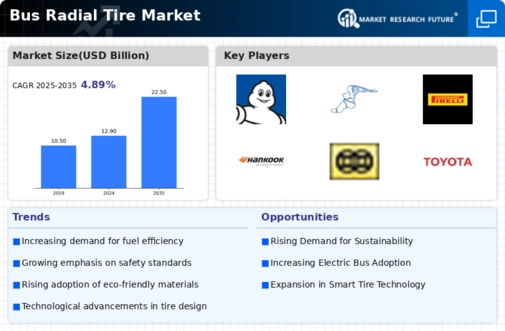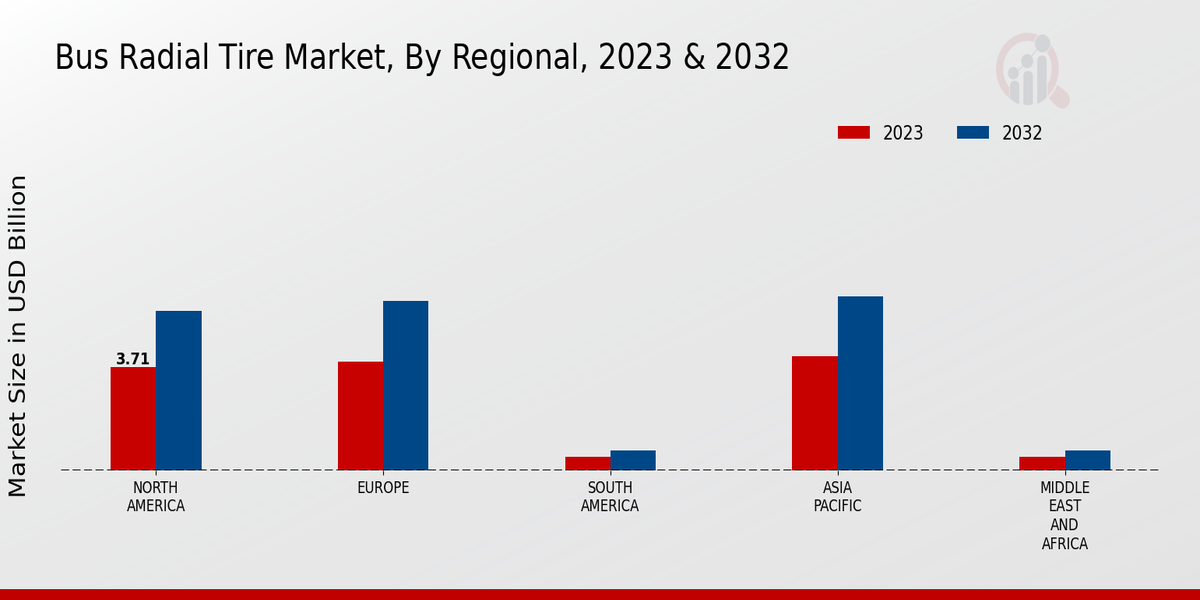Rising Fuel Prices
The Global Bus Radial Tire Market Industry is also affected by the fluctuations in fuel prices, which have a direct impact on operational costs for bus operators. As fuel prices rise, there is an increasing emphasis on fuel-efficient tires that can help mitigate these costs. Bus companies are more likely to invest in high-performance radial tires that offer better fuel economy, thereby reducing their overall expenditure. This trend is expected to contribute to a compound annual growth rate of 5.16% from 2025 to 2035, as operators seek to optimize their fleets and enhance profitability in a competitive market.
Increasing Urbanization
The Global Bus Radial Tire Market Industry experiences a notable boost due to the rapid urbanization occurring worldwide. As cities expand, the demand for public transportation, particularly buses, rises significantly. This trend is evident in regions such as Asia-Pacific, where urban populations are projected to increase dramatically. Consequently, the need for reliable and durable bus radial tires becomes paramount. The Global Bus Radial Tire Market Industry is expected to reach 12.9 USD Billion in 2024, driven by this urban growth. Enhanced public transport infrastructure further necessitates the adoption of high-quality tires, which can withstand the rigors of urban commuting.
Environmental Regulations
The Global Bus Radial Tire Market Industry is significantly influenced by stringent environmental regulations aimed at reducing carbon emissions and promoting sustainability. Governments worldwide are implementing policies that encourage the use of eco-friendly tires, which are designed to minimize environmental impact. For instance, regulations in Europe and North America mandate the adoption of low rolling resistance tires for public transport vehicles. This shift not only aligns with global sustainability goals but also drives demand for innovative tire solutions. As a result, manufacturers are compelled to invest in research and development, thereby enhancing the overall growth of the Global Bus Radial Tire Market Industry.
Market Growth Projections
The Global Bus Radial Tire Market Industry is projected to experience robust growth over the next decade. With an anticipated market value of 22.5 USD Billion by 2035, the industry is set to expand significantly. This growth trajectory is supported by various factors, including urbanization, technological advancements, and rising fuel prices. The compound annual growth rate of 5.16% from 2025 to 2035 indicates a strong market potential. Visual representations of this growth can be illustrated through charts that depict the increasing market size and the factors contributing to this upward trend.
Technological Advancements
Technological innovations play a crucial role in shaping the Global Bus Radial Tire Market Industry. The introduction of advanced materials and manufacturing processes has led to the development of tires that offer improved performance, safety, and fuel efficiency. For instance, the use of silica in tire compounds enhances grip and reduces rolling resistance, contributing to lower fuel consumption. As a result, fleet operators are increasingly investing in these technologically advanced tires to optimize operational costs. This trend is likely to propel the market towards an estimated value of 22.5 USD Billion by 2035, as more operators recognize the long-term benefits of such investments.
Growing Demand for Public Transport
The Global Bus Radial Tire Market Industry is witnessing a surge in demand for public transportation solutions, driven by the need for efficient and sustainable travel options. As urban populations grow, the reliance on buses as a primary mode of transport increases. This trend is particularly evident in developing countries, where investments in public transport infrastructure are on the rise. The Global Bus Radial Tire Market Industry is poised for growth, with projections indicating a market value of 12.9 USD Billion in 2024. This growing demand necessitates the production of high-quality radial tires that can support the increasing number of buses on the road.











